Vps34p differentially regulates endocytosis from the apical and basolateral domains in polarized hepatic cells
- PMID: 11564757
- PMCID: PMC2150819
- DOI: 10.1083/jcb.200105138
Vps34p differentially regulates endocytosis from the apical and basolateral domains in polarized hepatic cells
Abstract
Using a microinjection approach to study apical plasma membrane protein trafficking in hepatic cells, we found that specific inhibition of Vps34p, a class III phosphoinositide 3 (PI-3) kinase, nearly perfectly recapitulated the defects we reported for wortmannin-treated cells (Tuma, P.L., C.M. Finnegan, J.-H Yi, and A.L. Hubbard. 1999. J. Cell Biol. 145:1089-1102). Both wortmannin and injection of inhibitory Vps34p antibodies led to the accumulation of resident apical proteins in enlarged prelysosomes, whereas transcytosing apical proteins and recycling basolateral receptors transiently accumulated in basolateral early endosomes. To understand how the Vps34p catalytic product, PI3P, was differentially regulating endocytosis from the two domains, we examined the PI3P binding protein early endosomal antigen 1 (EEA1). We determined that EEA1 distributed to two biochemically distinct endosomal populations: basolateral early endosomes and subapical endosomes. Both contained rab5, although the latter also contained late endosomal markers but was distinct from the transcytotic intermediate, the subapical compartment. When PI3P was depleted, EEA1 dissociated from basolateral endosomes, whereas it remained on subapical endosomes. From these results, we conclude that PI3P, via EEA1, regulates early steps in endocytosis from the basolateral surface in polarized WIF-B cells. However, PI3P must use different machinery in its regulation of the apical endocytic pathway, since later steps are affected by Vps34p inhibition.
Figures
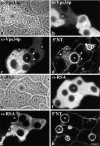

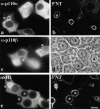
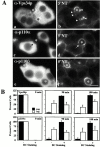

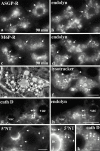

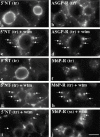

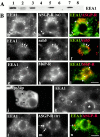
Similar articles
-
Evidence for apical endocytosis in polarized hepatic cells: phosphoinositide 3-kinase inhibitors lead to the lysosomal accumulation of resident apical plasma membrane proteins.J Cell Biol. 1999 May 31;145(5):1089-102. doi: 10.1083/jcb.145.5.1089. J Cell Biol. 1999. PMID: 10352024 Free PMC article.
-
Apical plasma membrane proteins and endolyn-78 travel through a subapical compartment in polarized WIF-B hepatocytes.J Cell Biol. 1998 Apr 6;141(1):115-33. doi: 10.1083/jcb.141.1.115. J Cell Biol. 1998. PMID: 9531552 Free PMC article.
-
Basolateral to apical transcytosis in polarized cells is indirect and involves BFA and trimeric G protein sensitive passage through the apical endosome.J Cell Biol. 1994 Jan;124(1-2):83-100. doi: 10.1083/jcb.124.1.83. J Cell Biol. 1994. PMID: 7905002 Free PMC article.
-
The subapical compartment: a traffic center in membrane polarity development.J Cell Sci. 2004 May 1;117(Pt 11):2183-92. doi: 10.1242/jcs.01217. J Cell Sci. 2004. PMID: 15126620 Review.
-
The subapical compartment and its role in intracellular trafficking and cell polarity.J Cell Physiol. 2000 Aug;184(2):151-60. doi: 10.1002/1097-4652(200008)184:2<151::AID-JCP2>3.0.CO;2-R. J Cell Physiol. 2000. PMID: 10867639 Review.
Cited by
-
The LTB4-BLT1 axis regulates the polarized trafficking of chemoattractant GPCRs during neutrophil chemotaxis.J Cell Sci. 2018 Sep 21;131(18):jcs217422. doi: 10.1242/jcs.217422. J Cell Sci. 2018. PMID: 30158177 Free PMC article.
-
Copper directs ATP7B to the apical domain of hepatic cells via basolateral endosomes.Traffic. 2014 Dec;15(12):1344-65. doi: 10.1111/tra.12229. Epub 2014 Oct 27. Traffic. 2014. PMID: 25243755 Free PMC article.
-
The type Ialpha inositol polyphosphate 4-phosphatase generates and terminates phosphoinositide 3-kinase signals on endosomes and the plasma membrane.Mol Biol Cell. 2005 May;16(5):2218-33. doi: 10.1091/mbc.e04-09-0799. Epub 2005 Feb 16. Mol Biol Cell. 2005. PMID: 15716355 Free PMC article.
-
Rab17 regulates apical delivery of hepatic transcytotic vesicles.Mol Biol Cell. 2018 Nov 15;29(23):2887-2897. doi: 10.1091/mbc.E18-07-0433. Epub 2018 Sep 26. Mol Biol Cell. 2018. PMID: 30256711 Free PMC article.
-
Cytokinesis defines a spatial landmark for hepatocyte polarization and apical lumen formation.J Cell Sci. 2014 Jun 1;127(Pt 11):2483-92. doi: 10.1242/jcs.139923. Epub 2014 Apr 4. J Cell Sci. 2014. PMID: 24706948 Free PMC article.
References
-
- Backer, J.M. 2000. Phosphoinositide 3-kinases and the regulation of vesicular trafficking. Mol. Cell. Biol. Res. Commun. 3:193–204. - PubMed
-
- Barr, V.A., and A.L. Hubbard. 1993. Newly synthesized hepatocyte PM proteins are transported in transcytotic vesicles in the bile duct-ligated rat. Gastroenterology. 105:554–571. - PubMed
-
- Barr, V.A., L.J. Scott, and A.L. Hubbard. 1995. Immunoadsorption of hepatic vesicles carrying newly synthesized dipeptidyl peptidase IV and polymeric IgA receptor. J. Biol. Chem. 46:27834–27844. - PubMed
Publication types
MeSH terms
Substances
Grants and funding
LinkOut - more resources
Full Text Sources
Research Materials
Miscellaneous

